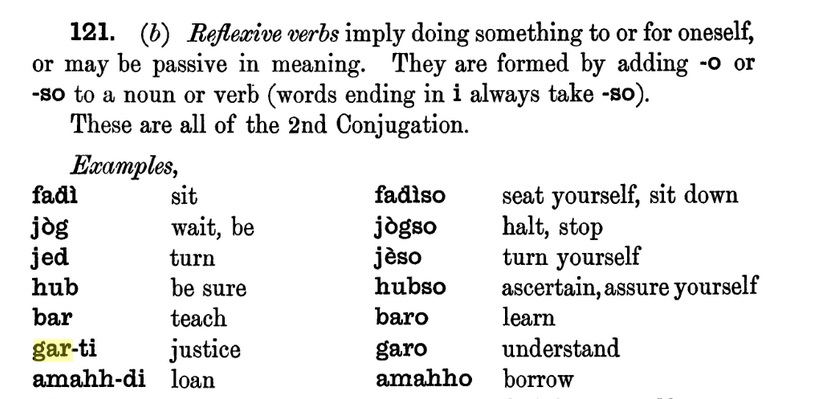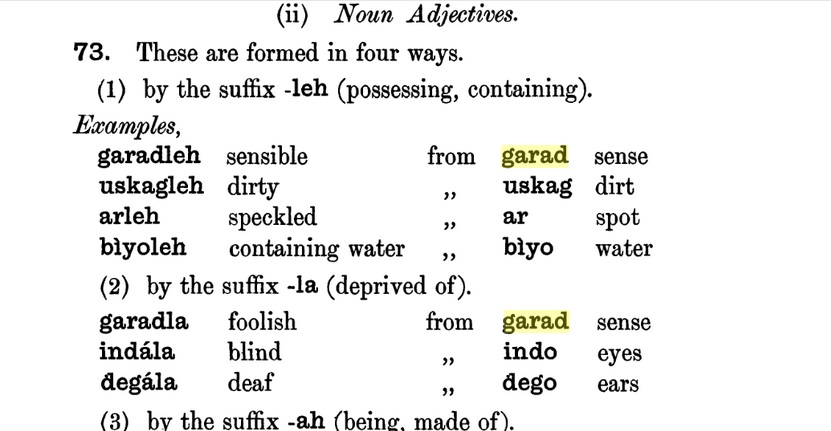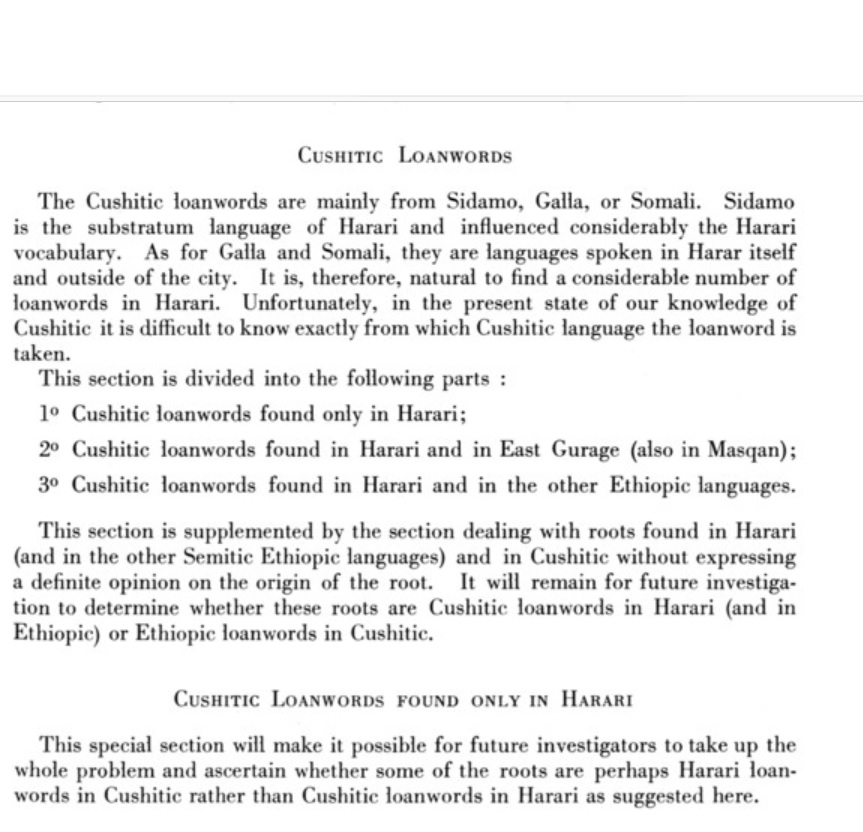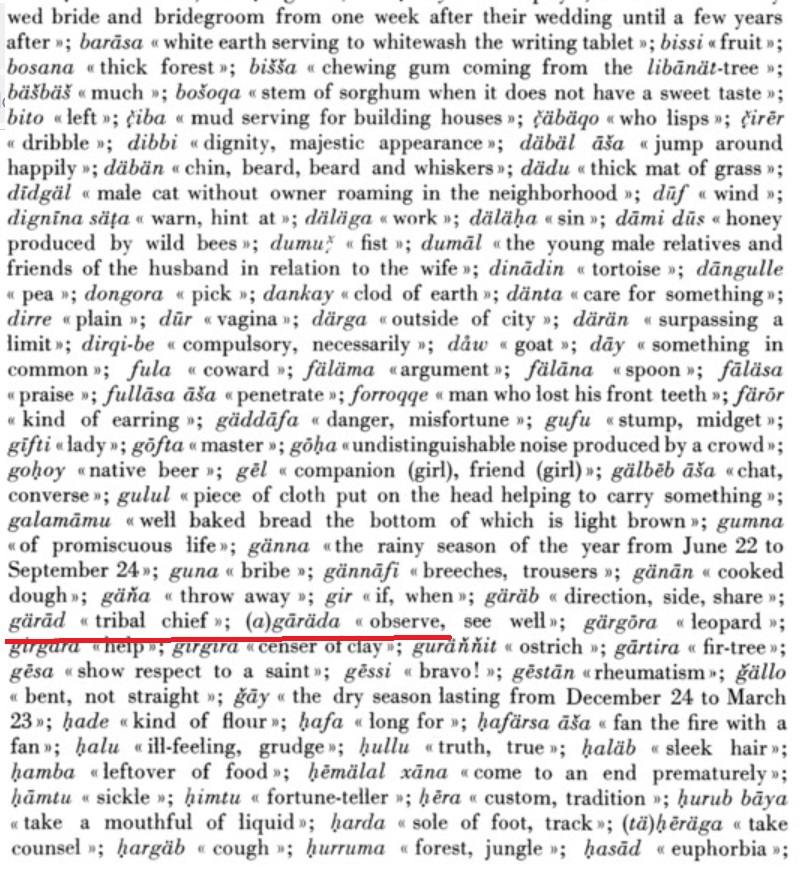Hi guys, I need your expertise again. Are titles like Garaad and Aw of Somali origin or were they loan words adopted from Ethiosemitic languages like Harari? Wikipedia believes the latter position.
 en.wikipedia.org
en.wikipedia.org
 en.wikipedia.org
en.wikipedia.org
You are using an out of date browser. It may not display this or other websites correctly.
You should upgrade or use an alternative browser.
You should upgrade or use an alternative browser.
Origins of Garaad
- Thread starter Zak12
- Start date
Wikipedia is full of revisionist trolls and especially the Horn of Africa pages are manipulated endlessly by Ethiopian right wingers.Hi guys, I need your expertise again. Are titles like Garaad and Aw of Somali origin or were they loan words adopted from Ethiosemitic languages like Harari? Wikipedia believes the latter position.
Garad - Wikipedia
en.wikipedia.org
Aw (father) - Wikipedia
en.wikipedia.org
There is no evidence that these terms were 'borrowed'. Garaad 100% has a Somali etymology. Even legendary linguists such as Leslau says that it is a 'Cushitic loanword' in Harari- i.e they borrowed it. The root of Garaad 'Gar' has many Somali words that form from it- it is a compound word of 'Gar' and 'Aad'.
Aw is literally 'father' in Maay and is also present in Maxaatiri in the form of 'Awoowe' and as a reference to a holy saint or awliyo 'Aw' Hebel.
The wiki page actually favours a local etymology rather than Ethiopian, so what are you talking about? Your fighting ghostsWikipedia is full of revisionist trolls and especially the Horn of Africa pages are manipulated endlessly by Ethiopian right wingers.
It may on this occasion but the pages are edited frequently and it has in the past along with multiple topics including Imam Ahmad claimed they are all 'Ethiopian'The wiki page actually favours a local etymology rather than Ethiopian, so what are you talking about? Your fighting ghosts
Riftvalley
VIP
There is actually another study which lists Garaad as a Somali loan word into Harari. There are other interesting words on there like Boon for low caste. I will try find it sometime and post it here.Harari as a language didn't exist 500 Years ago. Yet somehow it was borrowed and become common all over the somali penisula? That's obviously b.s . In fact stuff like this is why I doubt a lot of the "semetic loan words" in somali are real outside of the modern arabic ones.
Harari is an East Gurage language, the name Garaad or Aw/Ay is completely absent in Gurage or all other semetic languages. No words equivalent to them even exist, so it's uniquelly specific to it because it's a borrowing from Somali who they lived with in Harar. Magaalo (City) is also a borrowing from East Cushitic because it only exist in Afar & Somali.
Made a couple of posts about this before in a different thread.
You all welcome to read them:
Made a couple of posts about this before in a different thread.
You all welcome to read them:
It is obvious to anyone who even studies the etymology of the Somali language that Garaad has a Somali origin. It comes from the root etymology ''Gar'' which is the root construct of several legal and governance word constructs within the legal system of Xeer and the Somali language. Few examples i saw someone post elsewhere about the Xeer legal terminology, notice they all begin with ''Gar''
@KillStreakIsCool is spot on . Gar(Justice/Wisdom) + Aad (Move towards) = Garaad= One who moves towards or seeks Justice.
Some examples of other Somali word constructions using Gar-Garaad. From A Grammar of the Somali Language: With Examples in Prose and Verse by Kirk



Secondly it is well known by linguists and experts who even study Harari and Ethio-semetic languages that , ''Garaad'' and even ''Aw'' (Father) and ''Ay ''(Mother) are loan's from a cushitic source because there is no etymological links and nor does it have a Harari-Ethio-semetic root.
This is from the Vocabulary analysis of the Harari language by Wolf Leslau


He made the list but didn't locate which cushitic language is the definite source because of lack of lexical comparison from those languages at his disposal but i like that he is more honest than some of these writers who run of with assumptions, that turn out to be false,
Besides the word ''Garaad'' and ''Aw'', i can pick out a couple of loan words from the list that i think are Somali in origin like:
Dumaal, Bun(Coffee), Ay(Mother), Fula (coward), ilaalo/ilaalo(Watch tower), MaxMaxa(Proverbs), Dirre(Plain), Tumtu(ironsmith) , Garab( Side,direction), Waraba(hyena), Gessi (Brave), Danta(Care for something), Daran(surpassing limit), Bilis(who is not a slave), Bon(tanner) , sor/sur (food offered to a group of people on special occasion/ porridge) etc.
Aw also means father and Ay means mother in Af-Maay and several other archaic Sam-Langauge and dialects. You can look up lexical data on them and that's what it shows.
Some interesting observation by researchers:
In fact, titles preceding names are perceived by most Somalis to be an affectation. Luling, in her studies of the more settled Geledi Somalis noted that they used the word 'Aw (literally, ''father'') for ''Mr'' and the word Ai (literally, ''mother'') for ''Mrs''...
In both the North and South they extend it as an addage to saints and religious figures to show respect because they become figurative mothers/fathers and are later held as ancestors.
So it's pretty much rooted in Somalis unique culture of ancestor veneration and respect for elders.
Last edited:
Riftvalley
VIP
Thanks. This is the study I was talking about.Made a couple of post about this before in a different thread.
You all welcome to read them:
The loan word of Bon or Boon in Somali is actually an interesting socio economic phenomenons. You don’t adopt another groups word for a Low caste unless that group has a profound influence on your culture (through religion, proximity or deep trade). The same goes for Garaad, indeed if this did come from Somali to Harari which is is very likely-it says a lot about Somalis influence on their culture for them to have used a common tribal chieftain title for their leaders.
Not to mention all the cities across all of Somalia.Wikipedia is full of revisionist trolls and especially the Horn of Africa pages are manipulated endlessly by Ethiopian right wingers.
There is no evidence that these terms were 'borrowed'. Garaad 100% has a Somali etymology. Even legendary linguists such as Leslau says that it is a 'Cushitic loanword' in Harari- i.e they borrowed it. The root of Garaad 'Gar' has many Somali words that form from it- it is a compound word of 'Gar' and 'Aad'.
Aw is literally 'father' in Maay and is also present in Maxaatiri in the form of 'Awoowe' and as a reference to a holy saint or awliyo 'Aw' Hebel.
They even borrowed the word Xeer as heera meaning custom/law in Somali as well, noticed it from the list. So Garaad is even less suprising.Thanks. This is the study I was talking about.
The loan word of Bon or Boon in Somali is actually an interesting socio economic phenomenons. You don’t adopt another groups word for a Low caste unless that group has a profound influence on your culture (through religion, proximity or deep trade). The same goes for Garaad, indeed if this did come from Somali to Harari which is is very likely-it says a lot about Somalis influence on their culture for them to have used a common tribal chieftain title for their leaders.
Boon is less so about low caste as incorrectly interpreted. They are umbrella occupational names, simply.
Also it's not surprising that tumur/tumtu (Blacksmith/tumaal) and boon (tanner) are loans when you consider the fact that most black smiths/craftsments and weavers/leatherworkers in Harar were Somali. They call them Tumur collectively as a result of that.

Inside the city the artisans are concentrated in certain quarters:


Last edited:
Sometimes I really wonder whether @Idilinaa is the history part of my subconscious come to life and which started posting on Somalispot while I’m sleeping.
View attachment 329579
Haha i just love learning about stuff in general and share what i learn with others that are interested.
I am not really concerned with controlling what other people believe, i let them come to their own understandings even if i disagree. A lot of times you will learn a lot from disagreements than in agreements.
Aw means saint/highly devoted religious individual.Hi guys, I need your expertise again. Are titles like Garaad and Aw of Somali origin or were they loan words adopted from Ethiosemitic languages like Harari? Wikipedia believes the latter position.
Garad - Wikipedia
en.wikipedia.org
Aw (father) - Wikipedia
en.wikipedia.org
Garaad was a title in the Adal Empire and is used in Harar for one of the guardians of the gates I believe. even though it’s Somali, that explains why the confusion might come about, someone could have heard the Harari use first.Hi guys, I need your expertise again. Are titles like Garaad and Aw of Somali origin or were they loan words adopted from Ethiosemitic languages like Harari? Wikipedia believes the latter position.
Garad - Wikipedia
en.wikipedia.org
Aw (father) - Wikipedia
en.wikipedia.org
It is not random that the majority of Somalis living in Harar were Saab. Could you please share your source? I would like to read more about those papers.They even borrowed the word Xeer as heera meaning custom/law in Somali as well, noticed it from the list. So Garaad is even less suprising.
Boon is less so about low caste as incorrectly interpreted. They are umbrella occupational names, simply.
Also it's not surprising that tumur/tumtu (Blacksmith/tumaal) and boon (tanner) are loans when you consider the fact that most black smiths/craftsments and weavers/leatherworkers in Harar were Somali. They call them Tumur collectively as a result of that.

Inside the city the artisans are concentrated in certain quarters:


As for the word Boon, I don't believe it was borrowed since it is used by Southern Somalis. The name is associated with southern hunters and people who did work that was deemed unclean, which includes practically all types of employment in Somalia expect camel herding.
It is not random that the majority of Somalis living in Harar were Saab. Could you please share your source? I would like to read more about those papers.
As for the word Boon, I don't believe it was borrowed since it is used by Southern Somalis. The name is associated with southern hunters and people who did work that was deemed unclean, which includes practically all types of employment in Somalia expect camel herding.
I have explained Somali aritsan groups before: I shared a couple of studies on them and they all claim Northern Somali lineages. They are actually collectivelly called the Sab, ( not be confused with SAB the raxanweyn ancestor). But they are not related to eachother lineage wise and are widely spread out living amongst different Somali clans.
They are not subsistence hunters either, although they known to go out to gather materials to craft with.
Madhiban, Tumaal, Yibir is not 1 clan lineage or related to eachother, these are umbrella occupational names for certain Somali groups. The groups are scattered widely across the whole Somali regions. It is incorrect to call them a caste, and they are attached to other Somali clans as their patron/protectors:
The sab live scatttered all over Northern Somalilan in real or putative patri lineages on a pattern similar, though reduced, to those of their noble Somali (Ajji) protectors. In different regions they are known locally by the names of the eponyms of the small agnatic lineage groups into which they are divided, rather than their occupational classification as Midgan, Tumaal and Yibir. Ultimitely, however iti is as these and, collectively, as sab, that they are described. In the north the two largest Midgaan lineage groups are the Muuse Diiriye in the west and Midhiban in the east.
They all claim descent from the main Somali clans, Muuse Diriyee is Hawiye.
''Some Sab informants also, referring to well documented cases, maintain that they are of the same stock as the Somali but descend from small numerically weak lineage groups which were reduced to servitude by more powerful enemies. In support of these claims, Midgaan informants have produced genealogies tracing descent from Dir, the founder of the Dir clan familiy. Some Tumaal race descent from Darood founder of the noble Darood Somali clan family''
The only collective genetic data done on them is the one done by I.M Lewis and Goldsmith:
Goldsmith and I. M. Lewis (1958) say that the hunter and artisan castes among the Somali show no obvious physical differences from the “noble” Somali, speak the same language, are culturally similar, and that there are no “strong traditions” of their having had a separate origin. In addition, these authors report no significant differences between the Somali and their associated castes (called sub) in ABO, MN, and Rhesus blood group distribution, although the castes are endogamous and have presumably long been so.
And they concluded that their Bondsmen (Sab) sample was identitical to the other Somali clans:
our sab sample is thus virtually identical with that of the Somali....our results suggest that in serological characters there is no difference between those of the sab and those of noble Somali.
known to free-born Somali as Sab have frequently been described as low caste but they are more correctly bondsmen.
There is also difference between rural and urban artisan groups: They tend to conflate the two when they are speaking about them, socio-economically they are seperate and the latter-(Urban) is organized into formal guilds and produce things for market places for commercial use rather than local-personal use.
Urban ones were concentrated historically in interior towns like Luuq, Bardheere, Harar and on the coast in Zeila, Berbera, Merca, Mogadishu and Barawa etc.
I also want to clarify. There is a difference between Rural artisans like the Sab and the Urban Somali artisans who lived in towns/cities.
Historically urban Somali craftsmen/artisans were never bondsmen, or attached to serve another clan,. Unlike the rural ones, they crafted things for marketplaces and for commercial production. They also were included in leadership and rulership in the towns clan council of elders (Guurtis) and enjoyed equal status to other town inhabitants.
Socio-economically there is a difference to be made here. Because people incorrectly tend to try to extend the rural experience onto the urban experience:
Infact this was one of the main requirements that set the Urban Somali clans apart from the rural clans. That they ''must be a people of trades and occupation'' . As a Benadiri Shaykh Historian lays it down:
fi Aydarüs indicates that these are the elements that a lineage requires in order to be an urban clan. Indeed, if they are found to lack one of the first seven they are ‘with defect’. However, his agenda is not simply to isolate urbanites from pastoral society. Certainly, he cites a number of elements which distinguish urbanites from their rural cousins. Stipulations 4: that they must be a people of trades and
occupations, and 5: that there must be among them a doctor who can treat the people, are attributes found commonly only among urban clans. Others, however, are elements common to all clans, rural or urban, such as 1, 3, 6 and 7 relating to learning, bloodwealth, and leadership respectively
Explained this further on page 1 with another example of Harar Somalis in the 1800s:
But this is entirely different in an Urban town/city, from an urban point of view where they live in fixed settlements and neither raise livestock, nor farm much land , their value lies in craftsmanship and trade/commerce.
This is why most of the craftsmanship/artisan activities are dominated by Gibil Madow Somali urban clans on the Benadiri coast town. When Abgaal and Bimaal entered to controll the urban towns a section of them took up Artisan/Craftsman activities: Giungi and Kaafari
This is also seen within the city of Harar in the 1800s where Somalis are the main craftsmans/artisans: The History of Harar and Harari:
To concretize this relationship, here are some examples; Burton’s description of the population of the city of Harar shows there were 2500 Somalis engaged in different activities (Burton, R., 1956). The spatial organization of the city and the quarters also has some ethnic stratification. Accordingly, the Somalis were predominantly found in the Suqtat Bari, engaged in occupations such as handicraft, smithery and leatherwork.
Found some more information on Somali urban artisans and how they apparently organized themselves in guilds
From the; Peoples of the Horn of Africa (Somali, Afar and Saho): North Eastern
ARTISAN AND GUILD ORGANIZATIONS
These occur in the coastal towns of the south (there is no information for the north) and may well be the urban development of the institutions just described. A man wishing to apprentice his son to a carpenter, builder, or craftsman, takes him to the master with a gift (faddi). After a feast attended by apprentices at which roasted coffee is served, the lad joins the craftsman's family and remains under his authority. In return for lodging and keep, the apprentice works for his master's profit until, on reaching the status of craftsman, he desires to be independent. Then he purchases his freedom by a payment of money, a man's kercheif (garbasar) and a shield (gashan), returning his tools. Emancipation is celebrated ritually with feasting. It appears that often, by the time the apprentice is expert, his master has died, and we are not told what happens in this case.
There are similar guilds of weavers and silver-smiths, the second forming a kind of cast probably similar to the Tumaal..
@Shimbiris @xLibaxsenderx @Aurelian
Last edited:
It is obvious to anyone who even studies the etymology of the Somali language that Garaad has a Somali origin. It comes from the root etymology ''Gar'' which is the root construct of several legal and governance word constructs within the legal system of Xeer and the Somali language. Few examples i saw someone post elsewhere about the Xeer legal terminology, notice they all begin with ''Gar''
Gar (Justice/Wisdom) + Aad (Move towards) = Garaad = One who moves towards or seeks Justice.
you said : Gar (Justice/Wisdom) + Aad (Move towards) = Garaad = One who moves towards or seeks Justice .
I don't agree with your linguistic analysis .
This Somali agentive suffix (-aad) does not mean " to move or to go" .
This Somali agentive suffix (-aad) is a suffix convert verbs into nouns, effectively representing the actor performing a particular action.
The Somali agentive suffix (-aad ) added to the verb to form an agent noun ( اسم الفاعل ) . or ,
The Somali agentive suffix (-aad ) added to nouns to form an agent noun ( اسم الفاعل ).
The Somali agentive suffix (-aad ) : A person or thing that does an action indicated by the root verb; used to form an agent noun. denoting occupations .
what is the etymological explanation for the Somali word ( wadaad )?
wad f.g/mg1 (-day, -dday) 1. (f.g) Xoolo, dad iwm meel ay joogeen ka kaxeyn.
wadaad m.l (-ddo, m.l) Nin diinta islaamka wax ka bartay kuna camalfala oo dhowrsan.
wade m.l (-dayaal, m.l/dh) 1. Qof baabuurta wadi yaqaan.
wadaadnimo m.dh Wadaad ahaansho.
wad ( verb) : to continue , to carry on, to move , drive, to lead, to guide .
wade ( noun ) : driver .
wadid ( -da ) ( noun ) : driving .
wadaad ( -ka ) ( noun ) : man of religion, Muslim religious consultant .
wadne ( -ha ) ( noun ) : heart .
wadaadnimo ( -da ) ( noun ) : state of being a wadaad .
So wadaad is an agent noun ( اسم الفاعل ) which means he who leads ( from the somali verb " wad " + the Somali agentive suffix (-aad) .
from Wikipedia :
In linguistics, an agent noun (in Latin, nomen agentis) is a word that is derived from another word denoting an action, and that identifies an entity that does that action. For example, driver is an agent noun formed from the verb drive.
from Wikipedia :
An agentive suffix or agentive prefix is commonly used to form an agent noun from a verb. Examples: English: -er, -or, -ian, -ist .
you said : Gar (Justice/Wisdom) + Aad (Move towards) = Garaad = One who moves towards or seeks Justice .
I don't agree with your linguistic analysis .
This Somali agentive suffix (-aad) does not mean " to move or to go" .
This Somali agentive suffix (-aad) is a suffix convert verbs into nouns, effectively representing the actor performing a particular action.
The Somali agentive suffix (-aad ) added to the verb to form an agent noun ( اسم الفاعل ) . or ,
The Somali agentive suffix (-aad ) added to nouns to form an agent noun ( اسم الفاعل ).
The Somali agentive suffix (-aad ) : A person or thing that does an action indicated by the root verb; used to form an agent noun. denoting occupations .
what is the etymological explanation for the Somali word ( wadaad )?
wad f.g/mg1 (-day, -dday) 1. (f.g) Xoolo, dad iwm meel ay joogeen ka kaxeyn.
wadaad m.l (-ddo, m.l) Nin diinta islaamka wax ka bartay kuna camalfala oo dhowrsan.
wade m.l (-dayaal, m.l/dh) 1. Qof baabuurta wadi yaqaan.
wadaadnimo m.dh Wadaad ahaansho.
wad ( verb) : to continue , to carry on, to move , drive, to lead, to guide .
wade ( noun ) : driver .
wadid ( -da ) ( noun ) : driving .
wadaad ( -ka ) ( noun ) : man of religion, Muslim religious consultant .
wadne ( -ha ) ( noun ) : heart .
wadaadnimo ( -da ) ( noun ) : state of being a wadaad .
So wadaad is an agent noun ( اسم الفاعل ) which means he who leads ( from the somali verb " wad " + the Somali agentive suffix (-aad) .
from Wikipedia :
from Wikipedia :
It's not my linguistic analysis. It is actually from a study ( The Somali Customary Laws: ) that lists a glossary of Somali legal terminologies with the root ''Gar'' in them . Garaads are the chief administrators of xeer law.
Aside from this. That is very colorful, you should add more purple and yellow with a dash of orange to send the message home.
Trending
-
NSFW Breaking 🚨 conservative influencer Charlie Kirk shot in Utah
- Started by Chaseyourdreamzz
- Replies: 585
-
-
Guess which African Community in the US has the lowest Median Household Income?
- Started by lulu2
- Replies: 25
